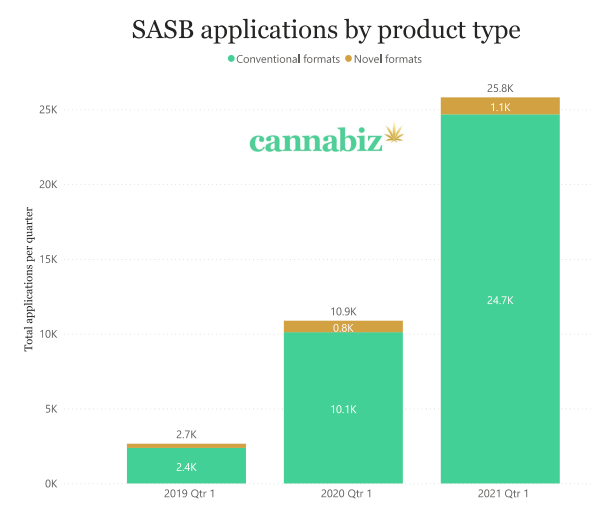In an exclusive taster for what’s coming up in our first Cannabiz Premium members-only webinar, editor-at-large Rhys Cohen analyses what the latest SAS-B data tells us about novel delivery mechanisms and their place in the Australian market.
Gel capsules, wafers, chew tablets, crystals, hard-shell capsules, topicals, and sprays. These novel delivery formats have been touted as the next wave of product innovation, designed to provide more accurate dosing and more convenient administration.

But according to newly released SAS-B data, none of these products have so far managed to capture any significant market share.
In the first quarter of the 2019 calendar year there were 280 SAS-B applications for novel products. That grew to 765 in Q1 2020 and 1,123 in Q1 2021. From 2019 to 2021, that represents a growth rate of more than 300%.
However, over the same time period, SAS-B applications for ‘conventional’ products (being oral oil and flower) grew by more than 900%, from 2,319 applications in 2019 to 10,879 in 2020 and 24,679 in 2021.
So, although the absolute number of SAS-B applications for novel products grew significantly over the last two years, this was eclipsed by conventional product formats, and the share of total SAS-B applications for novel products actually fell, from 10.5% of total applications in 2019 to 7% in 2020 and 4.3% in 2021.

Medicinal cannabis prescriber Dr Vicki Kotsirilos said she is not surprised that novel products have struggled to capture market share. “They might be excellent products, but sprays and capsules come in fixed doses that limit titration flexibility.”

“I like to start patients off on very low doses, and move up in small increments to reach a stable therapeutic dose that requires as little medication as possible. This reduces the likelihood of side effects, which is especially important for cannabis naive patients, and keeps product costs down.”
This is not practical with novel dose formats, she added: “You can’t really take half or a quarter of a spray.”
CA Clinics medical director and addiction specialist Dr Mark Hardy agreed the “fingertip control you get with oils” allows more flexibility with dosing.
“Some of these new formats have a lot of potential, especially the wafer products which are already widely used in the addiction medicine space. But it will take time for unfamiliar doctors to become educated about them, and feel comfortable in prescribing them,” he added.
What’s behind this apparent struggle for novel formats to cut through with doctors and patients using the SAS-B pathway?
Join us to discuss this and many more detailed insights into the changing landscape of products and patient demographics at the Cannabiz Premium members-only webinar at 5pm on Tuesday, June 29.
From patient demographics to preferred products: the changing face of Australian medicinal cannabis will see Editor-at-Large Rhys Cohen and co-founder Martin Lane present an exclusive analysis of the market followed by an audience Q&A.
A Premium membership costs just $249 plus GST for the year and gives you unlimited entry to all future events plus access to every news and analysis story on the Cannabiz website. Upgrade now.
Already a Premium member? Click here to book your spot
- All insights provided by Cannabiz are based on SAS-B application data alone, and do not include data on compounded or registered cannabis medicines, or on patients accessing medicinal cannabis through Authorised Prescribers or clinical trials. SAS-B applications are made by individual prescribers, and the details provided may be incomplete or incorrect.

